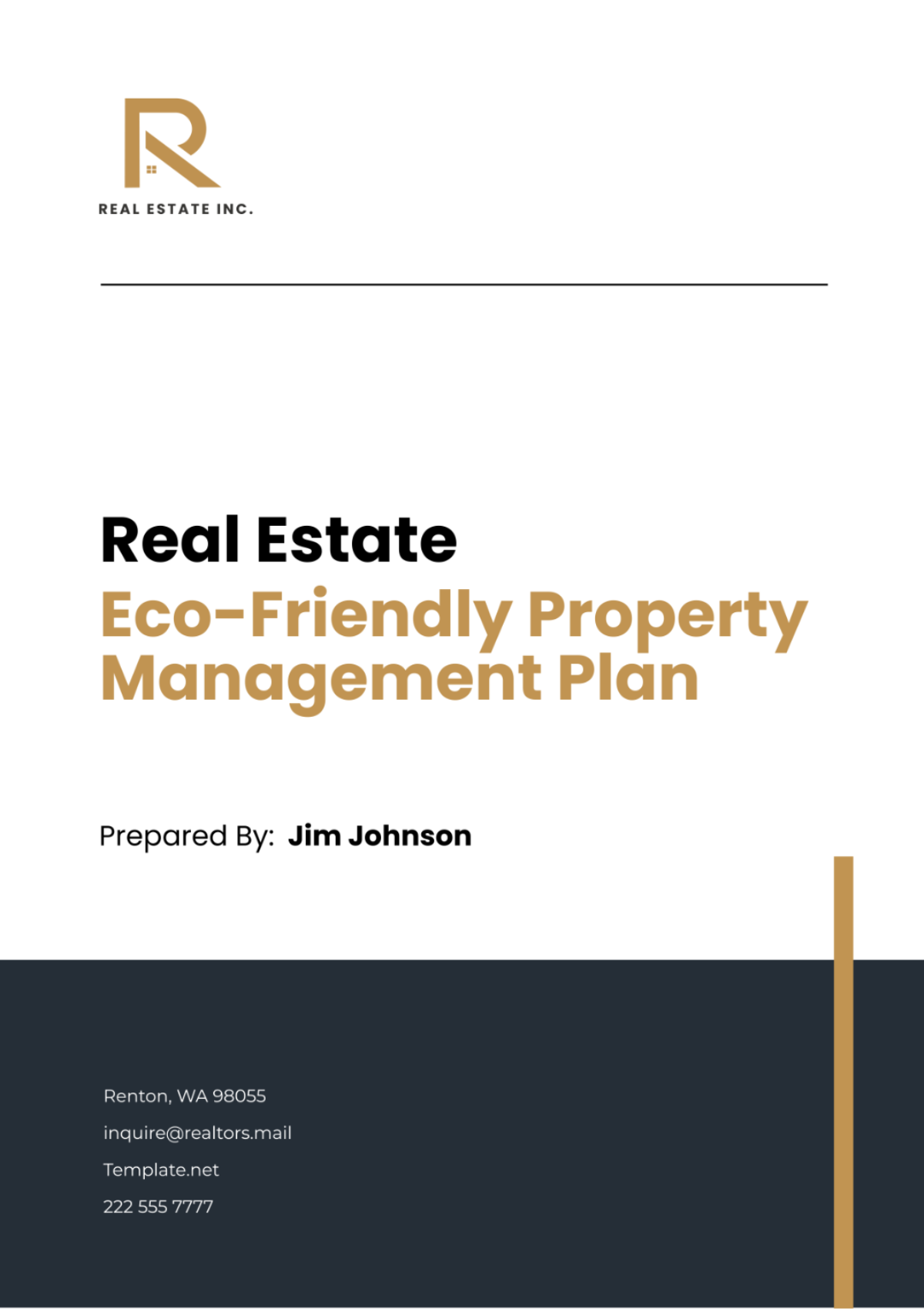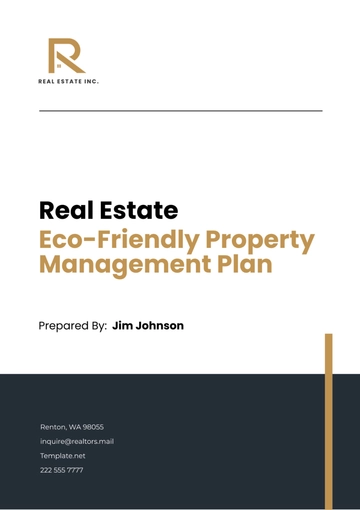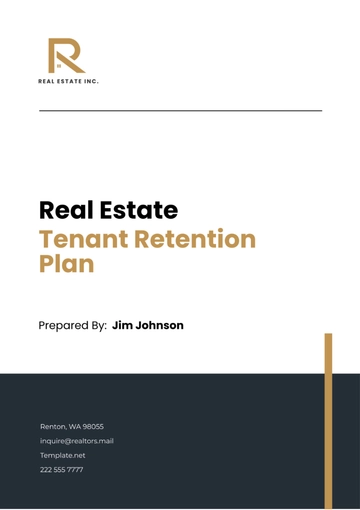Free Real Estate Eco-Friendly Property Management Plan

I. Introduction
In today’s world, the importance of sustainability and eco-friendliness cannot be understated. This plan outlines key strategies and actions to achieve this goal. It serves as a roadmap for [Your Company Name] to manage its properties in an environmentally friendly manner, reduce its carbon footprint, and contribute to a sustainable future.
A. Importance of Sustainability
Global Necessity: Sustainability is no longer a choice but a necessity in today’s world. It is crucial for the survival and prosperity of future generations. As a responsible real estate company, we understand our role in promoting sustainable practices.
Company Commitment: As a responsible real estate company, [Your Company Name] is committed to leading the way in sustainable property management. We believe that it is our responsibility to ensure that our operations have minimal impact on the environment.
Plan Purpose: This plan outlines our strategies and actions to manage our properties in an eco-friendly manner. It provides a clear direction for our team and sets measurable goals for us to achieve.
B. Goal of the Plan
Environmental Impact Reduction: The goal of this plan is to reduce the environmental impact of our properties. We aim to achieve this by implementing green building upgrades, promoting sustainable landscaping, educating tenants, and more.
Quality Living Spaces: By following this plan, we can make a positive impact on the planet while providing quality and eco-conscious living spaces. We believe that sustainability and quality can go hand in hand, and we are committed to proving it through our actions.
Stakeholder Engagement: We also aim to engage our stakeholders in our sustainability efforts. We believe that by working together, we can achieve greater results and make a significant contribution to environmental preservation.
II. Environmental Audit
A. Energy Consumption
Current Patterns: Assess the current energy consumption patterns of each property. Understanding how energy is currently used is the first step towards identifying opportunities for improvement. This involves analyzing energy bills, conducting energy audits, and consulting with energy experts.
1.1. Bill Analysis: Analyze energy bills to understand current energy usage patterns. This can provide insights into peak usage times, seasonal variations, and potential inefficiencies.
1.2. Energy Audits: Conduct energy audits to identify opportunities for energy conservation. This involves inspecting the property, analyzing energy usage, and identifying ways to improve energy efficiency.
1.3. Expert Consultation: Consult with energy experts to gain deeper insights into energy conservation opportunities. Experts can provide valuable advice on the latest energy-saving technologies and best practices.
Improvement Areas: Identify areas where energy efficiency can be improved. This could include upgrading to energy-efficient appliances, improving insulation, or implementing energy management systems.
2.1. Appliance Upgrades: Consider upgrading to energy-efficient appliances. Energy Star-rated appliances, for example, use less energy and can significantly reduce energy consumption.
2.2. Insulation Improvements: Improve insulation to reduce heating and cooling costs. This could involve upgrading windows, sealing drafts, and adding insulation to walls and roofs.
2.3. Energy Management Systems: Implement energy management systems to monitor and control energy usage. These systems can provide real-time data on energy consumption and help identify inefficiencies.
Goal Setting: Set goals for reducing energy consumption and monitor progress towards these goals. Regular monitoring and reporting will ensure that we stay on track and can quickly address any issues that arise.
3.1. Setting Targets: Set clear and achievable targets for energy reduction. These targets should be based on the results of the energy audit and expert advice.
3.2. Monitoring Progress: Regularly monitor progress towards the energy reduction targets. This involves tracking energy consumption, comparing it to the targets, and identifying any deviations.
3.3. Reporting: Regularly report on energy consumption and progress towards the targets. This will keep all stakeholders informed and ensure accountability.
B. Water Usage
Usage Evaluation: Evaluate water usage in each property and identify opportunities for conservation. This could involve installing water-efficient fixtures, implementing water-saving practices, or educating tenants about water conservation.
1.1. Water Audit: Conduct a water audit to understand current water usage patterns. This involves analyzing water bills, inspecting the property for leaks, and identifying water-intensive activities.
1.2. Water-Saving Fixtures: Consider installing water-saving fixtures such as low-flow faucets and showerheads, dual-flush toilets, and water-efficient appliances.
1.3. Water-Saving Practices: Implement water-saving practices such as rainwater harvesting, greywater recycling, and drip irrigation. These practices can significantly reduce water usage and help conserve this precious resource.
Conservation Measures: Implement water-saving measures such as low-flow fixtures and efficient irrigation systems. These measures can significantly reduce water usage without compromising on comfort or convenience.
2.1. Low-Flow Fixtures: Install low-flow fixtures to reduce water usage. These fixtures use less water per minute than standard fixtures, helping to conserve water without sacrificing performance.
2.2. Efficient Irrigation: Implement efficient irrigation systems such as drip irrigation or smart sprinklers. These systems deliver water directly to plant roots, reducing evaporation and runoff.
2.3. Rainwater Harvesting: Install rainwater harvesting systems to collect and use rainwater for irrigation. This can significantly reduce the need for potable water for irrigation.
Usage Monitoring: Monitor water usage regularly to ensure that conservation measures are effective. Regular monitoring will allow us to quickly identify and address any issues, ensuring that our water conservation efforts are successful.
3.1. Water Metering: Install water meters to monitor water usage. This can provide real-time data on water consumption and help identify any unusual usage patterns.
3.2. Regular Inspections: Conduct regular inspections to check for leaks and ensure that water-saving fixtures and systems are working properly.
3.3. Reporting: Regularly report on water usage and conservation efforts. This will keep all stakeholders informed and ensure accountability.
III. Green Building Upgrades
Implementing green building upgrades is a key strategy in our Eco-Friendly Property Management Plan. These upgrades not only improve the sustainability of our properties but also enhance their value and appeal. The following chart and table outline some potential green building upgrades, their benefits, estimated costs, and implementation timelines:
Upgrade | Benefits | Estimated Cost | Implementation Timeline |
|---|---|---|---|
Solar Panels | Generate renewable energy, reduce energy costs | $10,000 | 6 months |
Energy-Efficient Appliances | Lower energy consumption, reduce energy bills | $5,000 | 3 months |
Insulation Improvements | Improve energy efficiency, reduce heating/cooling costs | $7,000 | 4 months |
Water-Saving Fixtures | Reduce water usage, lower water bills | $3,000 | 2 months |
Sustainable Landscaping | Enhance biodiversity, reduce water usage | $8,000 | 5 months |
Total | $33,000 |
A. Solar Panels
Installing solar panels is a significant investment, but it can generate substantial returns in the form of renewable energy and reduced energy costs. Over time, the energy savings can offset the initial cost of the panels. Moreover, solar panels can enhance the appeal of our properties to environmentally conscious tenants and buyers.
B. Energy-Efficient Appliances
Replacing old appliances with energy-efficient models can significantly lower energy consumption and reduce energy bills. While the upfront cost can be higher than standard appliances, the long-term savings make this upgrade a smart investment. Plus, energy-efficient appliances often come with improved features and performance, adding to the appeal of our properties.
C. Insulation Improvements
Improving insulation can greatly enhance the energy efficiency of our properties, reducing heating and cooling costs. This upgrade involves an initial investment, but the savings on energy bills over time make it worthwhile. Additionally, improved insulation can enhance the comfort of our properties, making them more attractive to tenants and buyers.
D. Water-Saving Fixtures
Installing water-saving fixtures like low-flow faucets and showerheads can significantly reduce water usage and lower water bills. This upgrade is relatively inexpensive and easy to implement, but it can generate substantial savings over time. Plus, water-saving fixtures can appeal to environmentally conscious tenants and buyers.
E. Sustainable Landscaping
Implementing sustainable landscaping practices can enhance the biodiversity of our properties and reduce water usage. This upgrade involves an initial investment, but it can enhance the aesthetic appeal of our properties and attract tenants and buyers who value outdoor spaces and sustainability.
The importance of implementing green building upgrades cannot be overstated. These upgrades not only improve the sustainability of our properties but also enhance their value and appeal. By investing in green building upgrades, we can attract environmentally conscious tenants and buyers, reduce our operating costs, and contribute to a more sustainable future.
In a nutshell, implementing green building upgrades is a clear demonstration of our commitment to sustainability. It shows that we are not just talking about sustainability but actually taking concrete actions to achieve it. This can enhance our reputation as a responsible and sustainable real estate company, setting us apart from our competitors and making us a preferred choice for tenants and buyers.
IV. Sustainable Landscaping
Sustainable landscaping is a key component of our plan. It involves transforming outdoor spaces into sustainable landscapes that promote biodiversity, reduce water usage, and enhance the aesthetic appeal of our properties.
A. Native Species
Plant Selection: We will prioritize the use of native species in our landscaping. Native plants are adapted to the local climate and soil conditions, which means they require less water and care than non-native species. This not only reduces water usage but also lowers maintenance costs.
Biodiversity Promotion: Planting native species also promotes biodiversity by providing habitat for local wildlife. This can help to balance the local ecosystem and contribute to a healthier environment.
Tenant Engagement: We will engage our tenants in our native planting initiatives. This could involve organizing planting days or educational workshops. This not only enhances community spirit but also raises awareness about the importance of biodiversity.
B. Rainwater Harvesting
Water Conservation: We will install rainwater harvesting systems to collect and store rainwater for irrigation. This is a highly effective way to conserve water and reduce our reliance on municipal water supplies.
Cost Savings: Rainwater harvesting can also lead to significant cost savings. By using harvested rainwater for irrigation, we can reduce our water bills and make our properties more cost-effective.
Tenant Education: We will educate our tenants about our rainwater harvesting systems and the benefits of rainwater harvesting. This will help to foster a culture of sustainability among our tenants and encourage them to adopt similar practices in their own homes.
C. Drip Irrigation
Efficient Water Use: We will implement drip irrigation systems in our landscapes. Drip irrigation is a highly efficient method of watering plants because it delivers water directly to the plant roots, reducing evaporation and runoff.
Healthier Plants: Drip irrigation can also lead to healthier plants. Because it provides a slow and steady supply of water, it helps to maintain optimal soil moisture levels and promotes healthier plant growth.
Cost and Water Savings: While drip irrigation systems require an initial investment, they can lead to significant water and cost savings in the long run. By reducing water wastage, they can help to lower water bills and make our properties more cost-effective.
V. Tenant Education
Educating tenants about the importance of sustainability and encouraging them to participate in eco-friendly practices is a key component of our plan. By empowering our tenants with knowledge and resources, we can foster a culture of sustainability within our properties.
A. Energy Conservation
Resource Provision: We will provide resources on energy conservation to help tenants reduce their energy usage. These resources could include guides on energy-efficient appliances, tips on reducing energy waste, and information on the benefits of energy conservation.
Workshops and Seminars: We will organize workshops and seminars on energy conservation. These events will provide tenants with practical knowledge and skills to reduce their energy consumption. They will also provide an opportunity for tenants to ask questions and share their own energy-saving tips.
Recognition and Rewards: We will recognize and reward tenants who make significant efforts to conserve energy. This could involve featuring them in our newsletters, providing them with small rewards, or acknowledging them at community events. This will motivate other tenants to adopt energy-saving practices.
B. Waste Reduction and Recycling
Tips and Guidelines: We will offer tips on waste reduction and recycling to help tenants minimize their waste. This could involve providing guidelines on what can be recycled, tips on reducing food waste, and information on the environmental impact of waste.
Recycling Facilities: We will provide recycling bins and clearly communicate recycling guidelines. This will make it easy for tenants to recycle and help increase the recycling rate within our properties.
Community Clean-Up Events: We will organize community clean-up events. These events will not only help keep our properties clean but also foster a sense of community and shared responsibility for the environment.
VI. Monitoring and Reporting
Implementing a system to monitor and track the effectiveness of eco-friendly initiatives is crucial for the success of our plan. Regular reporting allows us to measure our progress, identify areas for improvement, and keep all stakeholders informed. The following table outlines the key aspects of our monitoring and reporting process:
Aspect | Description |
|---|---|
Energy and Water Usage | Regularly review energy and water usage data to monitor the effectiveness of our conservation efforts. |
Green Building Standards | Conduct audits to ensure compliance with green building standards. |
Waste Management | Track waste diversion rates and evaluate the effectiveness of waste reduction strategies. |
Tenant Feedback | Collect and analyze feedback from tenants to assess their satisfaction with our eco-friendly initiatives. |
Reporting to Stakeholders | Provide regular reports to property owners, tenants, and other stakeholders to keep them informed about our progress. |
Energy and Water usage involves regularly reviewing energy and water usage data. This allows us to monitor the effectiveness of our conservation efforts and identify areas for improvement. By tracking our usage over time, we can measure the impact of our initiatives and make data-driven decisions to enhance our sustainability efforts.
Green Building Standards on the other hand, involves conducting audits to ensure compliance with green building standards. These audits help us ensure that our properties meet the highest standards of sustainability and energy efficiency. They also provide an opportunity to identify areas where we can further improve our properties’ environmental performance.
Waste management involves tracking waste diversion rates and evaluating the effectiveness of our waste reduction strategies. By monitoring how much waste we are able to divert from landfills through recycling and composting, we can assess the success of our waste management practices and identify opportunities to further reduce waste.
Tenant feedback also involves collecting and analyzing feedback from tenants. This feedback can provide valuable insights into how our eco-friendly initiatives are perceived by those who live in our properties. It can help us understand what we are doing well and where we can improve to better meet our tenants’ needs and expectations.
Moreover, reporting to stakeholders involves providing regular reports to property owners, tenants, and other stakeholders. These reports keep everyone informed about our progress and demonstrate our commitment to transparency and accountability. They can also help build trust and foster a sense of shared responsibility for sustainability among all stakeholders.
Monitoring and reporting are critical components of our Eco-Friendly Property Management Plan. They allow us to measure our progress, hold ourselves accountable, and continuously improve our practices. By regularly reviewing our performance and reporting our findings, we can ensure that our plan remains effective and responsive to changing needs and circumstances.
VII. Partnerships and Collaborations
Establishing partnerships with local organizations and businesses is crucial. These partnerships can enhance our sustainability efforts, provide valuable resources and expertise, and promote community engagement.
A. Environmental Nonprofits
Collaboration: We will collaborate with environmental nonprofits for resources and guidance. These organizations have a wealth of knowledge and experience in sustainability, and their insights can greatly enhance our efforts.
Shared Goals: By partnering with environmental nonprofits, we can work towards shared goals of environmental conservation and sustainability. This can lead to more effective and impactful initiatives.
Community Engagement: These partnerships can also help us engage with the local community. Nonprofits often have strong community ties, and their involvement can help foster a sense of community ownership and participation in our sustainability efforts.
Education and Awareness: Environmental nonprofits can also help us educate our tenants and the wider community about the importance of sustainability. They can provide educational materials, organize workshops, and help raise awareness about environmental issues.
Policy Development: We can also work with environmental nonprofits to develop and refine our sustainability policies. Their expertise can ensure that our policies are effective, comprehensive, and aligned with best practices.
B. Green Building Suppliers
Eco-Friendly Materials: We will partner with green building suppliers to source eco-friendly materials for our properties. These suppliers specialize in products that are environmentally friendly and sustainable.
Cost Savings: By partnering with green building suppliers, we can often secure discounts on eco-friendly materials. This can help us keep our costs down while still achieving our sustainability goals.
Innovation: Green building suppliers are often at the forefront of innovation in sustainable materials and technologies. By partnering with them, we can stay up-to-date with the latest developments and incorporate them into our properties.
Quality Assurance: Working with reputable green building suppliers can also give us confidence in the quality of the materials we use. We can trust that the products we are getting are not only eco-friendly but also durable and high-quality.
C. Local Businesses
Community Ties: We will establish partnerships with local businesses to enhance our sustainability efforts. Local businesses are often well-connected within the community, and these partnerships can help us foster stronger community ties.
Joint Initiatives: We can work with local businesses on joint sustainability initiatives. This could include community clean-up events, recycling programs, or educational workshops.
Economic Impact: By partnering with local businesses, we can also contribute to the local economy. This can help create jobs, support local industries, and foster economic growth.
Tenant Services: Partnerships with local businesses can also enhance the services we offer to our tenants. For example, we could partner with a local grocery store to offer delivery services to our tenants, reducing the need for car trips.
Public Relations: These partnerships can also enhance our public relations. They can show that we are committed to the local community and invested in its success.
VIII. Conclusion
By implementing the strategies and actions outlined in this plan, we aim to create sustainable properties that benefit the environment, tenants, and the community at large. Our commitment to sustainability is reflected in every aspect of our property management, from the materials we use to the partnerships we form. We believe that by making sustainability a priority, we can contribute to a healthier planet and provide a better living environment for our tenants.
In addition to the environmental benefits, our sustainability efforts also have significant social and economic benefits. They enhance the appeal of our properties to environmentally conscious tenants and buyers, reduce our operating costs, and contribute to a sustainable local economy. Moreover, they enhance our reputation as a responsible and sustainable real estate company. Together, we can make a positive impact on the planet while providing quality and eco-conscious living spaces. We look forward to continuing our sustainability journey and working with all our stakeholders to create a more sustainable future.
- 100% Customizable, free editor
- Access 1 Million+ Templates, photo’s & graphics
- Download or share as a template
- Click and replace photos, graphics, text, backgrounds
- Resize, crop, AI write & more
- Access advanced editor
Manage your properties sustainably with our Real Estate Eco-Friendly Property Management Plan Template! This editable and customizable template, made available for you here on Template.net, allows you to create a comprehensive property management plan that prioritizes eco-friendliness. With our advanced AI Editor Tool, creating your plan is seamless! Get started!
You may also like
- Finance Plan
- Construction Plan
- Sales Plan
- Development Plan
- Career Plan
- Budget Plan
- HR Plan
- Education Plan
- Transition Plan
- Work Plan
- Training Plan
- Communication Plan
- Operation Plan
- Health And Safety Plan
- Strategy Plan
- Professional Development Plan
- Advertising Plan
- Risk Management Plan
- Restaurant Plan
- School Plan
- Nursing Home Patient Care Plan
- Nursing Care Plan
- Plan Event
- Startup Plan
- Social Media Plan
- Staffing Plan
- Annual Plan
- Content Plan
- Payment Plan
- Implementation Plan
- Hotel Plan
- Workout Plan
- Accounting Plan
- Campaign Plan
- Essay Plan
- 30 60 90 Day Plan
- Research Plan
- Recruitment Plan
- 90 Day Plan
- Quarterly Plan
- Emergency Plan
- 5 Year Plan
- Gym Plan
- Personal Plan
- IT and Software Plan
- Treatment Plan
- Real Estate Plan
- Law Firm Plan
- Healthcare Plan
- Improvement Plan
- Media Plan
- 5 Year Business Plan
- Learning Plan
- Marketing Campaign Plan
- Travel Agency Plan
- Cleaning Services Plan
- Interior Design Plan
- Performance Plan
- PR Plan
- Birth Plan
- Life Plan
- SEO Plan
- Disaster Recovery Plan
- Continuity Plan
- Launch Plan
- Legal Plan
- Behavior Plan
- Performance Improvement Plan
- Salon Plan
- Security Plan
- Security Management Plan
- Employee Development Plan
- Quality Plan
- Service Improvement Plan
- Growth Plan
- Incident Response Plan
- Basketball Plan
- Emergency Action Plan
- Product Launch Plan
- Spa Plan
- Employee Training Plan
- Data Analysis Plan
- Employee Action Plan
- Territory Plan
- Audit Plan
- Classroom Plan
- Activity Plan
- Parenting Plan
- Care Plan
- Project Execution Plan
- Exercise Plan
- Internship Plan
- Software Development Plan
- Continuous Improvement Plan
- Leave Plan
- 90 Day Sales Plan
- Advertising Agency Plan
- Employee Transition Plan
- Smart Action Plan
- Workplace Safety Plan
- Behavior Change Plan
- Contingency Plan
- Continuity of Operations Plan
- Health Plan
- Quality Control Plan
- Self Plan
- Sports Development Plan
- Change Management Plan
- Ecommerce Plan
- Personal Financial Plan
- Process Improvement Plan
- 30-60-90 Day Sales Plan
- Crisis Management Plan
- Engagement Plan
- Execution Plan
- Pandemic Plan
- Quality Assurance Plan
- Service Continuity Plan
- Agile Project Plan
- Fundraising Plan
- Job Transition Plan
- Asset Maintenance Plan
- Maintenance Plan
- Software Test Plan
- Staff Training and Development Plan
- 3 Year Plan
- Brand Activation Plan
- Release Plan
- Resource Plan
- Risk Mitigation Plan
- Teacher Plan
- 30 60 90 Day Plan for New Manager
- Food Safety Plan
- Food Truck Plan
- Hiring Plan
- Quality Management Plan
- Wellness Plan
- Behavior Intervention Plan
- Bonus Plan
- Investment Plan
- Maternity Leave Plan
- Pandemic Response Plan
- Succession Planning
- Coaching Plan
- Configuration Management Plan
- Remote Work Plan
- Self Care Plan
- Teaching Plan
- 100-Day Plan
- HACCP Plan
- Student Plan
- Sustainability Plan
- 30 60 90 Day Plan for Interview
- Access Plan
- Site Specific Safety Plan










